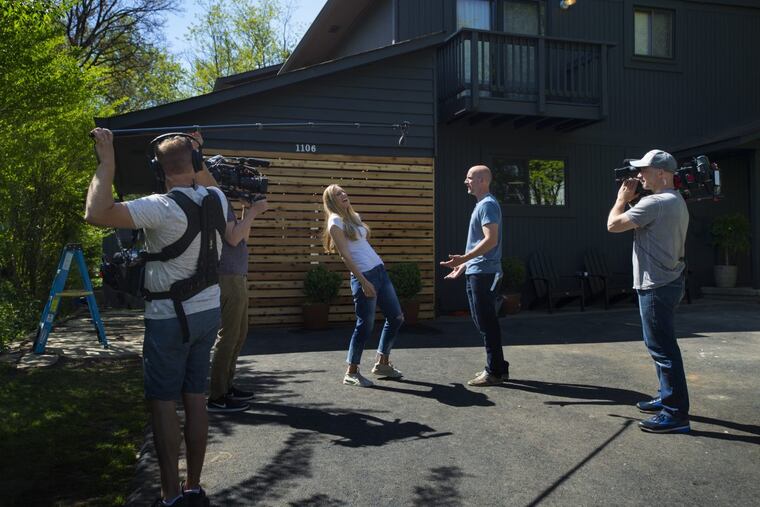As seen on TV: Many homeowners find inspiration in home makeover programs
Homeowners, real estate agents, and home buyers and sellers find themselves in a housing market that's almost as influenced by reality TV as a property's good bones (or good school district).

When Kuangchi Chang and her husband, Robert Peterson, were planning a kitchen renovation in 2015, they drew on a lot of professional help. And we're not talking only about the contractors who transformed the den and sun porch of their 1970s Colonial into a sleek white-and-gray cucina. Chang, a confessed HGTV fanatic, watched countless episodes of such shows as Property Brothers, Love It or List It and Flip or Flop.
"We moved the kitchen to a completely different area in the house, installed an extra window and turned our old kitchen into a family room," Chang said. "I probably wouldn't have thought all that was possible without HGTV."
Homeowners, real estate agents, and home buyers and sellers find themselves in a housing market that's almost as influenced by reality TV as a property's good bones (or good school district). Real estate agents, designers and market watchers say design trends, selling practices and budget expectations can all be colored by factors such as photogenic Chip and Joanna Gaines' farmhouse-rustic rehabs on Fixer Upper or the aggressive pricing strategies on Flip or Flop.
HGTV's widespread influence is not surprising: Since the network was launched on basic cable in 1994, its viewership has skyrocketed. According to the most recent Nielsen ratings, HGTV is the fourth-most-watched cable network in the United States, averaging more than 1.6 million viewers overall.
"HGTV represents the idea that if you improve or upgrade your house, you'll improve your life," says Baltimore blogger Kate Wagner, who runs the tongue-in-cheek website Mcmansionhell.com. "It's appealing, but in many ways it's escapism. Remodels and real estate transactions aren't this easy in real life."
D.C.-area real estate agent Mandy Mills says she and her partner joke that they live in HGTV world. "In any property we show, everything has to be together. … The way reality TV depicts homes going from grungy to beautiful means that we stage nearly every listing we sell."
Yet not all house hunters expect pristine, recently updated properties. HGTV also has taught many people to look beyond frumpy 1980s oak kitchen cabinets and closed-off layouts. Channeling suave Property Brothers real estate agent/rehabber twins Jonathan and Drew Scott, buyers now can envision open floor plans in cramped Victorian rowhouses and gleaming, white-on-white kitchens supplanting beaten-up 1970s Formica and linoleum.
"HGTV has given people some self-confidence to take on houses they wouldn't ordinarily have taken on," says Great Falls, Va., interior designer Lauren Liess, who is filming the first season of her own HGTV makeover show, The Best House on the Block. "Audiences see the transformations, and it's easier for them to imagine what can be done to an older place or a cookie-cutter home."
On her show, homeowners leave the big decisions and remodeling completely in Liess and her team's paintbrush or hammer-wielding hands, a common practice on makeover shows. More design clients and buyers are willing to take risks or accept edgier concepts from the pros, she said.
HGTV programming also seems to be spreading home design trends — colors, materials, furniture styles — from one region of the country to another. Take the breezy, beachy vibes (glass tile, muted pastels) of the California-based Flip or Flop, or the modern farmhouse chic (white furniture, vintage signs) of Fixer Upper from Waco, Texas.
"We have started getting more requests for shiplap," says Bill Millholland, an executive vice president at remodeling firm Case Design/Build, referring to the grooved, interlocking wooden boards that Fixer Upper uses to add rustic flair to everything from kitchen islands to bedroom ceilings.
"Things are so stylized and location-specific on some of these programs," Millholland said. "Sometimes you can't have a two-story foyer in your 1920s townhouse, and the indoor-outdoor spaces you see on a show shot in California aren't very practical" for all climates.
A series shot in a different region can also give audiences a kind of reverse sticker shock. "In TV land, everything seems so easy and inexpensive," said Mills, of the D.C. area. "That's challenging for Realtors, because we get customers who are comparing the price of a renovation in Ohio with what it would cost here."
And in one episode's time frame, a project (or home sale) that could take months of wrangling, permitting and contracts in real life gets compressed into a lightning-fast segment with a (usually) happy ending.
"I like that HGTV is making consumers more interested and informed about remodeling and real estate," says Marymount University interior design professor Jean Freeman. "But they don't show realistic time frames. It takes three to six months to do a kitchen. And you can't just order furniture and appliances and have them show up the next day. It's a process."